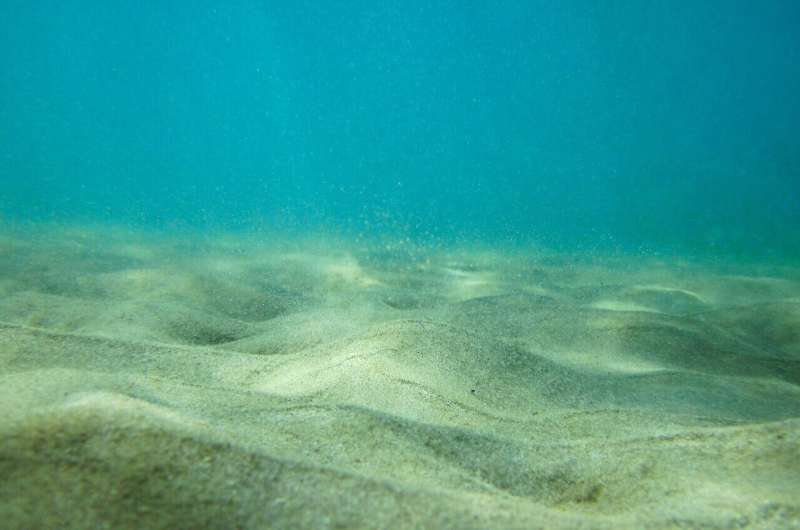Credit: CC0 Public Domain
Geologists are interested in the sedimentary cycle—erosion from mountains that forms sand that is carried out to the ocean—because it's foundational for understanding how the planet works.
It's also crucial for understanding the global sand budget and planning offshore operations like oil extraction, wind farms, and carbon sequestration. Now, researchers have taken a broad look at ancient Earth's sedimentary cycle during an extremely hot period in search of clues about the impacts of extreme climate events.
By synthesizing global data on deep-sea sand deposits, researchers identified a signal or "fingerprint" of extreme climate change from about 50 million years ago: turbidite deposits. These deposits, evidence of ancient rapid submarine water currents, are thought to be caused by the downslope transport of sediment that has accumulated at the top of the continental slope.
"This suggests that extreme weather events and exacerbated global climatic conditions contributing to increased erosion of landscapes could amplify delivery of sand into the deep ocean," said Stanford University adjunct lecturer Zack Burton, lead author on a study detailing the findings published Feb. 8 in Scientific Reports.
High seas
The research challenges a long-held notion that sea-level changes are the dominant influence on sand deposits in the deep sea. When sea level is low, there's a better chance for sediment eroded off mountains to find its way to the deep sea. Many researchers have theorized that high seas prevent sand from being deposited to deep seas because coastal plains and underwater continental shelves could be barriers to sand reaching deep waters.
But according to the study authors' compilation of 59 instances of early Eocene turbidite systems active 56 million to 48 million years ago, climatic conditions and tectonic activity may be more important than sea-level changes for deep-sea sand deposition.
"We suspected this was true, but we hadn't realized the magnitude of examples that have been documented in the literature," said senior study author Stephan Graham, the Welton Joseph and Maud L'Anphere Crook Professor in the Stanford Doerr School of Sustainability. "There were many more of those deep-water deposits than we had realized."
In the paper, the researchers present a conceptual model suggesting that conditions like intense precipitation and integrated river drainages can cause abundant sand-rich deep-marine deposits despite exceptionally high sea levels.
Hothouse planet
Earth during the early Eocene 56 million to 48 million years ago had the highest sea levels—with oceans over 200 feet above current levels—since before the sudden mass extinction of three-quarters of the planet's plant and animal species about 66 million years ago. There were rainforests in the Arctic, and alligators lived in the Dakotas.
While some of these conditions may be unfathomable, present-day climate change is giving us glimpses of the extreme climate events that besieged the early Eocene.
"As the Earth gets hotter and hotter because CO2 increases the greenhouse effect and sea level rises even further, then we would expect the increasing intensity of storms, higher precipitation rates—based on climate modeling by other people—to have much more impact in terms of sediment getting to the deep sea," Graham said.
While that may not be relevant anytime soon, the power of turbidity currents shouldn't be underestimated for future-proofing the next generations. The sediment-laden flows known as turbidity currents are like the devastating glowing avalanches that cascade down erupting volcanoes, Graham said.
Researchers first found out about turbidity currents because they were snapping transatlantic telegraph cables in 1929. "They're very powerful submarine flows of tremendous scale," Burton said.
With this synthesis of turbidity deposits from such a critical time in Earth's history, the researchers hope others will continue speculating about the aspects of warmer climates that may be impacting the global sedimentary cycle.
"Other factors, like human interactions with sedimentary systems and the terrestrial world we all live in, are combining to influence movement of sediment," Burton said. "I think it's hard to consider from an everyday perspective, just because we don't see these systems—they're part of the beautiful mystery of the deep ocean which we know so little about."
Stanford co-authors include Tim McHargue and alumni Chris Kremer (now at Brown University), Jared Gooley (now at the U.S. Geological Survey Alaska Science Center), Chayawan Jaikla (now at Microsoft), and Jake Harrington.
More information: Zack Burton et al, Peak Cenozoic warmth enabled deep‐sea sand deposition, Scientific Reports (2023). DOI: 10.1038/s41598-022-27138-2 , www.nature.com/articles/s41598-022-27138-2
Journal information: Scientific Reports
Provided by Stanford University
























